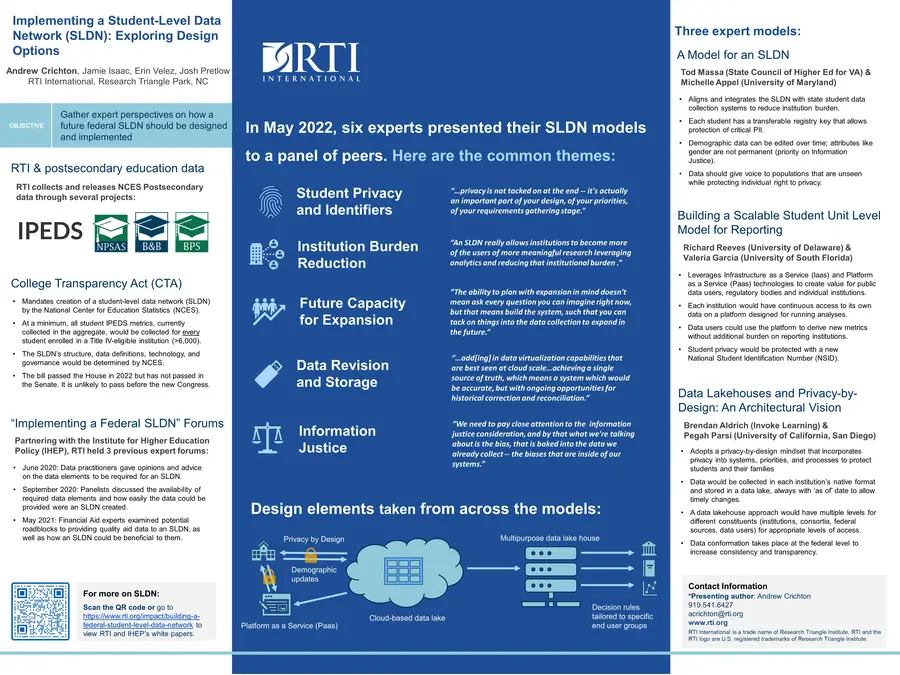Toward a Student-Level Data Network
Since 2019, RTI International has been investigating key considerations for a federal Student-Level Data Network (SLDN), a student-level data collection including all students attending U.S. postsecondary institutions that receive Title IV funding. In partnership with the Institute for Higher Education Policy (IHEP), RTI has held four forums with experts in postsecondary institutional and financial aid data and published summary briefs of each of the discussions. The fourth forum that RTI hosted shifted focus from discussing the data content and collection to the technology and infrastructure design for an SLDN. The RTI team presented its ideas to a unique audience at the EDUCAUSE conference in late 2022.
EDUCAUSE Conference Presentation
EDUCAUSE is a nonprofit professional association for those who work at the intersection of higher education and information technology. Its annual conference gathers administrative and IT staff from postsecondary institutions around the country and professionals from technology providers and related companies to discuss how trends in information technology can improve services and address challenges facing postsecondary education.
At the 2022 conference, RTI presented a poster distilling aspects of potential SLDN technical designs highlighted during RTI’s forum and resulting paper. Three pairs of experts representing four institutions, one state agency, and one private technology company laid out their suggested potential models for an eventual SLDN. The poster touched on key design themes and highlighted quotes from the experts:
- Student privacy: “…privacy is not tacked on at the end -- it's actually an important part of your design, of your priorities, of your requirements gathering stage.”
- Future capacity for expansion: “The ability to plan with expansion in mind doesn't mean ask every question you can imagine right now, but that means build the system, such that you can tack on things into the data collection to expand in the future.”
- Data revision and storage: “…add[ing] in data virtualization capabilities that are best seen at cloud scale…achieving a single source of truth, which means a system which would be accurate, but with ongoing opportunities for historical correction and reconciliation.”
- Information justice: “We need to pay close attention to the information justice consideration, and by that what we're talking about is the bias, that is baked into the data we already collect -- the biases that are inside of our systems.”
The Poster Session format allowed for one-on-one conversations with a broad range of postsecondary professionals, from data integration specialists and chief technology officers to academic deans and grants administrators. For the RTI team, this was a shift in perspective from the people who define and report student data, to the people who create and extract the data.
- Concern about burden: The first reaction of nearly every attendee was that providing data for an SLDN would require a substantial increase in effort from their institution to meet the new reporting requirements. Institution size seemed to correlate with concern; the chief information officer of one large public university said they could handle the change “no problem”, while a CIO from a small private college said they lacked the staff to respond to student-level reporting.
- Student privacy paramount: An SLDN would contain sensitive data on financial aid, student outcomes, and more, directly associated with individual students. Several attendees emphasized that the analytical benefits of having data for each student needed to be balanced with well-designed privacy safeguards, like a unique identifier distinct from Social Security Number.
- Possibilities of cloud technology: Data lakes, cloud analytics, and data governance were hot topics at the EDUCAUSE conference, and session attendees were happy to provide feedback on the technical aspects of the experts’ SLDN designs. The CTO of a small private college expressed enthusiasm over one design featuring Platform as a Service (PaaS). Under this model, the system would allow institutions to continuously update their data while providing automatic analytics. One data integration specialist from a technical institute noted that the changing priorities of their Institutional Research and Financial Aid departments were difficult to keep up with, but that cloud-based decision rules would allow much more agility in their response.
While the topics discussed only scratch the surface of the technological considerations around the implementation of an SLDN, the 2022 EDUCAUSE Conference was a great venue for the RTI team to continue its conversation about student-level data with a new audience. The most recent legislation for creating an SLDN stipulated a four-year implementation period, during which critical design decisions would be made. RTI remains committed to continuing conversations to bring to light ideas and technologies to facilitate creation of a high-quality student-level data system if one is passed into law.



